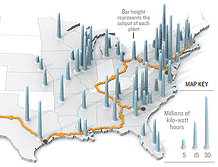The high cost of going nuclear
Power companies are lining up to build new plants after a decade of stagnation. What's standing in the way?
 |
| Southern Company's Vogtle Electric Generating Plant, near Waynesboro, Ga. |
(Fortune) -- If the companies that supply nuclear power plants are ready for a revival, the utilities that will operate the plants are champing at the bit.
Dale Klein, chairman of the Nuclear Regulatory Commission, said he's expecting license applications for 27 new nuclear reactors in the next two years. The Nuclear Energy Institute, the industry trade group, says it could be as many as 31.
This is a huge development, considering it's been more than three decades since the last successful attempt to license and build a new nuclear power plant in the United States got underway, and more than ten years since that plant went online.
I asked MIT professor Andy Kadak how to account for the recent flurry of new activity. "One is that nuclear plant performance has dramatically improved," he said. "In the early 1980s the capacity factor" - how much electricity the average nuclear plant generates, expressed as a percentage of capacity - "was in the low 60s. Today it's the low 90s. We used to have refueling outages that lasted 90 days. Now they do it in 27. Good ones are 21.
"Utilities are making a lot of money from nukes today. That's given the utility CEOs confidence to say, 'Look, these plants are running well, we're making money and if we buy into nuclear, there's no reason not to expect similar performance in the future if we run them as we know how to run them now.'
"That's a big plus. The other thing is deregulation. It forced utilities to be competitive in terms of how much their power costs. That was a factor driving efficiency and lowering operating costs. Then came the new designs. Vendors innovated and made reactors simpler and safer."
Barnie Beasley, Chief Executive of Southern Nuclear, added one more key factor: Soaring demand, especially in the fast-growing South, where more than half the new plants are planned.
"Obviously in Georgia we're experiencing a lot of economic growth, a lot of population growth," Beasley said, while showing me around Southern's Vogtle generating station in the piney woods outside Waynesboro, Ga.
Already Vogtle has two huge Westinghouse reactors generating more than 1000 megawatts each; Southern wants to build two more, doubling capacity. "Our projection over the next 20 years in terms of population is we're going to add another entire Atlanta in the state of Georgia," Beasley continues. "We are going to have to provide large base-load units to provide the power."
The largest remaining obstacle to such plans? Cost. Consider a typical scenario in which a utility with a $9 billion market cap wants to build a nuke plant with a $5 billion price tag. "You put that on your balance sheet," as one former utility executive explained to me, "and you know what Wall Street would do with your bond ratings."
The cost factor is the background to the generous set of nuclear subsidies contained in the Energy Policy Act of 2005. Among them: a tax credit of 1.8 cents per kilowatt hour for early movers, capped at $6 billion; regulatory risk insurance to cover licensing delays, potentially worth $2 billion; and federal loan guarantees that could pay up to 80 percent in the event of default. (Only the risk insurance applies specifically to nukes; the others cover wind, solar and biofuels as well.)
But at least one utility executive - CEO David Crane of NRG Energy, which plans to add two new reactors to its existing South Texas Project, near Bay City, Texas - thinks the industry may be asking for too much help from taxpayers.
"People in nuclear industry complain that everyone remembers Three Mile Island and Chernobyl," he said. "On the other hand, the nuclear plants remember that, too. They're cautious. They want everybody else to take all the risks.
"Guys, get over it," he said. "Sure, nuclear plants are expensive. And power companies are not as big as oil companies. But one of the things about being in business is you get a reward for taking a risk. I just get the sense that while the industry likes to say, 'The government is not doing enough, the government is not doing enough,' it's time for the industry to step up."
Email: dwhitford@fortunemail.com ![]()
-
 The retail giant tops the Fortune 500 for the second year in a row. Who else made the list? More
The retail giant tops the Fortune 500 for the second year in a row. Who else made the list? More -
 This group of companies is all about social networking to connect with their customers. More
This group of companies is all about social networking to connect with their customers. More -
 The fight over the cholesterol medication is keeping a generic version from hitting the market. More
The fight over the cholesterol medication is keeping a generic version from hitting the market. More -
 Bin Laden may be dead, but the terrorist group he led doesn't need his money. More
Bin Laden may be dead, but the terrorist group he led doesn't need his money. More -
 U.S. real estate might be a mess, but in other parts of the world, home prices are jumping. More
U.S. real estate might be a mess, but in other parts of the world, home prices are jumping. More -
 Libya's output is a fraction of global production, but it's crucial to the nation's economy. More
Libya's output is a fraction of global production, but it's crucial to the nation's economy. More -
 Once rates start to rise, things could get ugly fast for our neighbors to the north. More
Once rates start to rise, things could get ugly fast for our neighbors to the north. More








